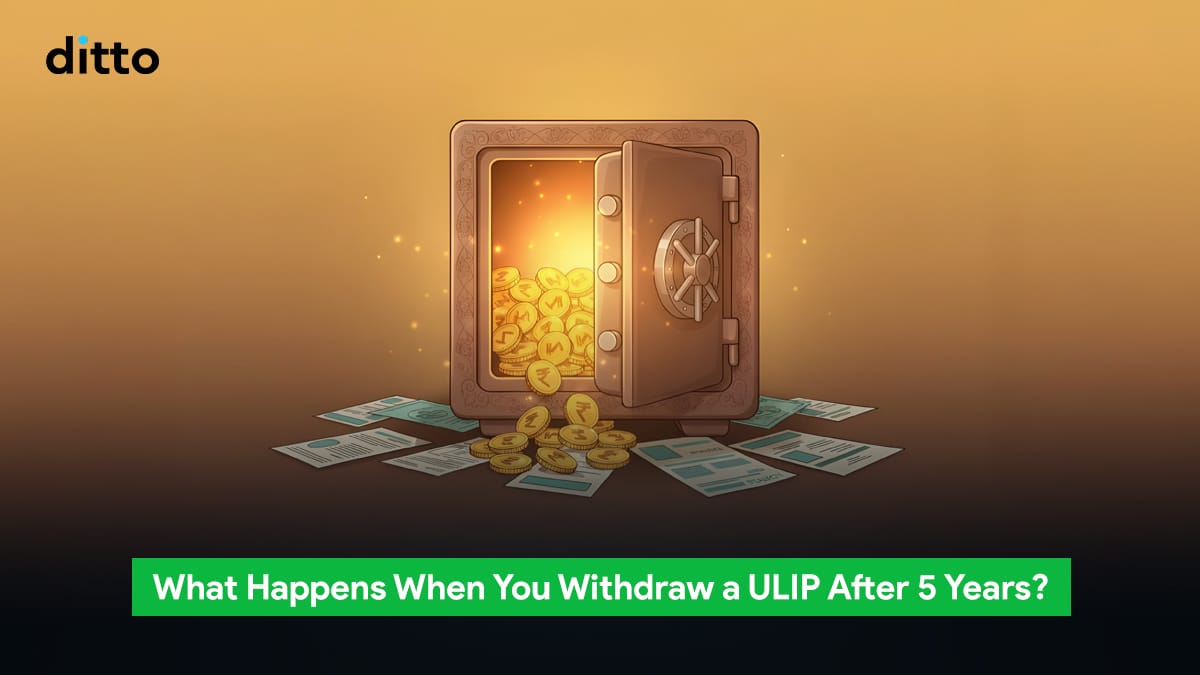| What Happens When You Withdraw a ULIP After 5 Years? After completing the mandatory five-year lock-in period, you can withdraw funds from your ULIP either partially or fully. Partial withdrawal allows you to keep the policy active, while a full withdrawal ends both your investment and life cover. Withdrawals after five years are generally tax-free under Section 10(10D), provided your annual premium does not exceed ₹2.5 lakh. To withdraw, ensure your policy is active, check your fund value, select the type of withdrawal, and submit your request. Payments are usually processed within seven working days. Withdrawals before completing five years are not allowed; in such cases, your policy is discontinued, the funds are moved to a Discontinued Policy Fund earning 4% interest, and the life cover stops. |
Unit-linked Insurance Plans (ULIPs) are financial products that combine investment and life insurance. But what happens when you want to withdraw funds after the mandatory lock-in period of five years?
According to the IRDAI (Insurance Products) Regulations, 2024, every ULIP has a five-year lock-in period from the date of commencement. After this period, ULIPs become liquid, allowing partial or full withdrawals from the accumulated fund value. If the policy is surrendered before five years, the invested amount is moved to a Discontinued Policy Fund (DPF), which earns limited returns until the lock-in period is complete.
Friendly reminder: It’s easy to get lost comparing policies and premiums. Instead of spending hours on it, why not get personalized insurance advice from Ditto? We offer free consultations with zero spam! Just 30 minutes to clarify all your doubts. So book a call now.
Types of ULIP Withdrawals
There are mainly two types of withdrawals in ULIPs:
1. Partial Withdrawal:
This allows you to withdraw a portion of your accumulated fund value after the lock-in period. Most insurers, like SBI Life, HDFC Life, and Bajaj Allianz, permit partial withdrawals from the sixth policy year onwards, provided the policyholder is alive and the policy is active.
For example:
a) Bajaj Allianz Life Goal Assure allows withdrawals after the 5-year lock-in with limits based on the policy term and fund value.
b) HDFC Life Click 2 Wealth permits partial withdrawals after the lock-in, provided the minimum balance remains in the fund.
c) SBI Life Wealth Creator allows partial withdrawals of up to 20% of the fund value after the 5th year.
Partial withdrawals are ideal for short-term goals like education, emergency funds, or home renovation without liquidating the entire policy.
2. Full Withdrawal (Surrender):
If you decide to exit completely after 5 years, you can surrender the policy. The insurer will pay you the fund value on the date of withdrawal, minus applicable charges, if any. Once surrendered, the life cover ceases, and you cannot revive the same policy later.
How Partial Withdrawals Impact Life Coverage?
A lesser-known aspect of ULIPs is that withdrawals can influence your life cover.Here’s how it works:
When you make a partial withdrawal, your life cover (sum assured) generally remains intact. However, as per IRDAI rules, the sum assured on death may be reduced only to the extent of withdrawals made in the two years immediately preceding death.
This reduction applies only to withdrawals from the base premium fund value; top-up withdrawals do not impact the sum assured.For instance, if your ULIP has a sum assured of ₹10 lakh and you withdraw ₹1 lakh within two years before death, your effective life cover may reduce to ₹9 lakh.
IRDAI also mandates that the death benefit should never fall below 105% of total premiums paid at any point (IRDAI Master Circular on Life Insurance Products, 2024).
Additionally, frequent withdrawals can hurt long-term wealth creation, as the withdrawn units stop compounding. While ULIPs offer flexibility, using this feature judiciously ensures your protection and growth stay intact.
Limits on ULIP Withdrawal
IRDAI allows insurers to define limits to prevent misuse. Here’s what most insurers follow:
1) Fund Value Requirement: A minimum balance (say, 3x annual premium) must remain post-withdrawal to keep the policy active.
2)Eligibility: Allowed only if the policyholder is at least 18 years old.
3) Gap Between Withdrawals: Usually, one year between each withdrawal.
4) Maximum Withdrawal: Typically 20%–25% of the fund value.
5) Minimum Withdrawal: ₹5,000 or as defined by the insurer.
6) Lock-in Period: No withdrawals in the first 5 years.
If the remaining fund value drops below the required limit, your policy may lapse or lose its life cover benefits.
Example: HDFC Life Click 2 Wealth requires that the post-withdrawal fund value is at least equal to one annual premium. Bajaj Allianz requires that the total withdrawals do not exceed 25% of the total fund value.
What Happens If You Withdraw Before 5 Years?
If you withdraw or surrender a ULIP before 5 years:
The life cover ceases immediately upon discontinuation.
1) The policy terminates immediately.
2) You can only access this amount after completion of 5 policy years.
3) The DPF earns a minimum guaranteed return of 4% p.a., as per IRDAI guidelines.
4) The fund value (after deducting charges) is transferred to a Discontinued Policy Fund (DPF).
In essence, early withdrawal locks your money with minimal returns, making it wiser to wait till the fifth year to gain access and preserve tax benefits.
How to Withdraw a ULIP Policy?
Here’s how the process works:
1. Check Eligibility:
Before initiating any withdrawal, confirm that your ULIP has completed five policy years. The lock-in period begins from the policy commencement date, not the date of your first premium payment. Also, ensure:
a) The policy is active and in force (all due premiums are paid).
b) You are the primary policyholder making the withdrawal request. If your policy has lapsed or been discontinued earlier, you’ll only receive your funds once the 5-year lock-in ends from the Discontinued Policy Fund (DPF).
| Did You Know? Top-up premiums come with a separate 5-year lock-in from the date of each top-up, independent of the main policy’s lock-in. Also, as per IRDAI rules, top-up withdrawals don’t reduce the sum assured when calculating the minimum death benefit floor (unlike base-fund withdrawals made within 2 years before death). How is this relevant to ULIPs? This means any additional investment you make in your ULIP through top-up premiums follows its own separate 5-year lock-in period, and withdrawals from these top-ups do not impact your ULIP’s minimum death benefit calculation. |
2. Assess Fund Value:
Next, review your current fund value and Net Asset Value (NAV) before deciding how much to withdraw. Since ULIPs are market-linked, the fund value fluctuates daily based on market performance. You can:
a) Log in to your insurer’s online portal or app.
b) Check your latest fund statement or annual premium statement.
c) Speak to your insurance advisor for a fund performance summary.
This step ensures you don’t withdraw during a market dip or when your fund value is lower than usual.
Example: If your HDFC Life Click 2 Wealth fund is currently valued at ₹7.5 lakh and your annual premium is ₹1 lakh, you can withdraw up to 20–25% (around ₹1.5–₹1.8 lakh), depending on the policy rules.
3. Submit the Withdrawal Request:
Once you’ve decided, submit your withdrawal request through any of these channels:
a) Self-attested photograph and contact details
b) Cancelled cheque or bank statement for payout verification
c) Valid ID and address proof (Aadhaar, PAN, etc.)
d) Original policy document (for surrender cases)
Offline: Visit the nearest branch office and submit a ULIP Withdrawal/Surrender Form along with:
Online: Log in to your insurer’s customer portal or app, navigate to the “Fund Withdrawal” or “Surrender” section, and fill in the details.
The insurer will verify your KYC documents and fund eligibility before initiating the transaction.
Example: SBI Life and Bajaj Allianz both offer online partial withdrawal options where funds are credited directly to your registered bank account after authentication.
4. Wait for Processing:
Once the request is submitted, the insurer typically processes the payment within 7 working days, depending on documentation and verification timelines. You’ll receive:
a) A confirmation message once the amount is transferred to your bank account.
b) An acknowledgment email or SMS upon submission.
c) If you’ve requested a full surrender, the policy will be closed, and you’ll get a surrender value statement confirming the payout and policy termination.
5. Understand Tax Implications:
Withdrawals after 5 years usually qualify for tax exemption under Section 10(10D) of the Income Tax Act, provided:
a) The total sum assured is at least 10 times the annual premium.
b) Your annual premium does not exceed ₹2.5 lakh, and
c) If your ULIP premium exceeds this threshold (for policies issued after February 2021), the gains become taxable as capital gains under Section 112A.
Example: If you invested ₹2 lakh per year for 6 years and your fund value is ₹15 lakh, your withdrawal (partial or full) will be tax-free.
However, if your annual premium was ₹3 lakh, your gains will now attract 12.5% long-term capital gains (LTCG) tax on profits exceeding ₹1.25 lakh per financial year, provided the equity or equity-oriented ULIP units have been held for more than 12 months.
6. Keep a Record of Your Withdrawal:
Always maintain copies of:
a) Tax certificate (if applicable)
b) Fund statement showing withdrawal value
c) Transaction receipts
d) Withdrawal/surrender acknowledgment
These records can help resolve disputes or clarify tax positions later.
Why Talk to Ditto for Term Insurance?
At Ditto, we’ve assisted over 8,00,000 customers with choosing the right insurance policy. Why customers like Arun below love us:

✅No-Spam & No Salesmen
✅Rated 4.9/5 on Google Reviews by 15,000+ happy customers
✅Backed by Zerodha
✅Dedicated Claim Support Team
✅100% Free Consultation
You can book a FREE consultation here. Slots are running out, so make sure you book a call now.
Ditto’s Take on ULIP Withdrawal After 5 Years
Many people get stuck with ULIPs that don’t really fit their financial goals. The good news? After five years, you can withdraw your money, but here’s something most policyholders don’t realize: you must keep at least one year’s premium (around ₹1 lakh for many plans) with the insurer. This amount ensures that your insurance cover stays active and also covers policy-related charges.
However, the rules differ across insurers and plans. Some may require a higher balance to keep your life cover intact, while others automatically adjust your fund value after withdrawal. That’s why it’s crucial to check your policy terms before deciding.
If you’ve realized that your ULIP isn’t the right fit for your long-term plan, you can withdraw after five years and redirect your investments elsewhere. But before you exit, make sure you retain your life insurance protection by switching to a dedicated term insurance plan.
At Ditto, we’ve seen countless investors withdraw from ULIPs only to find themselves underinsured later. That’s why our advisors recommend securing a term insurance plan first; it gives you the same life cover at a much lower cost, without the investment lock-in.
Frequently Asked Questions (FAQs)
How much money can be withdrawn in partial withdrawals?
You can withdraw up to 20–25% of your fund value, depending on the insurer’s terms, after completing 5 years.
Will GST apply to premiums and charges for life insurance?
No, from 22 September 2025, individual life insurance policies, including ULIPs, are fully exempt from GST, as per the latest decision by the GST Council.
Is ULIP withdrawal taxable?
No, withdrawals are tax-free under Section 10(10D) if your annual premium does not exceed ₹2.5 lakh and you meet the lock-in criteria.
Can I withdraw before 5 years?
No. Any withdrawal before 5 years leads to policy discontinuation, and your money stays locked in the Discontinued Policy Fund until the lock-in period ends.
What happens to my policy after full withdrawal?
Once surrendered, the policy terminates, and both life cover and investment benefits stop permanently.
Last updated on:








